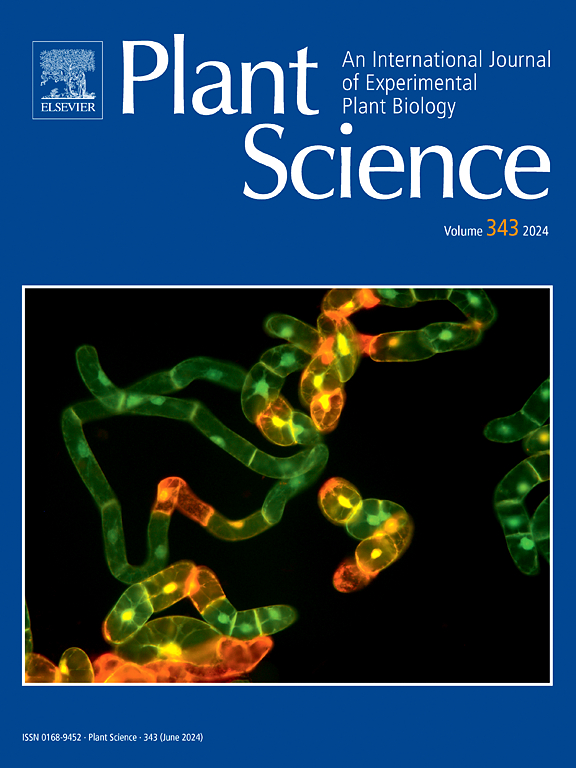A novel F-box gene, SlSE2.2, is responsible for the stigma exsertion degree in tomato (Solanum lycopersicum)
IF 4.2
2区 生物学
Q2 BIOCHEMISTRY & MOLECULAR BIOLOGY
引用次数: 0
Abstract
Tomato stigma exsertion is an important trait in positional sterility genotypes, which can eliminate the need for manual emasculation and promote hybrid production. In this study, we discovered a new tomato accession, J59, with a stably inherited stigma exsertion trait. To explore the regulatory genes of the stigma exsertion trait, J59 and inserted stigma genotypes M82 were crossed to obtain mapping populations. Through three years mapping, a quantitative trait locus (QTL) associated with the stigma exsertion trait was narrowed down to a 52.635 kb interval on chromosome 2, Solyc02g087270 was identified as the candidate gene responsible for this trait, named SlSE2.2. This gene encoded an F-box protein of the FBA subfamily. Sequences analysis revealed that an 11 bp deletion occurred in the first exon of SlSE2.2 in J59, resulting in premature termination of translation. Subcellular localization revealed that SlSE2.2 is located to the nucleus. Knockout of SlSE2.2 increased anther and style lengths, which reduced the values of anther length minus pistil length, changing the relative length of anthers and pistils, called stigma exsertion degree, whereas, overexpression of SlSE2.2 showed the opposite phenotype. Hormone levels analysis revealed that SlSE2.2 negatively modulated IAA, ETH, and JA levels and positively modulated ABA content. Transcriptomic analysis showed that SlSE2.2 affected the expression of SlIAA19, SlIAA36, SlETR6, SlJAZ, and SlSnRK2 related to the hormone signal transduction. This study identified the important role of a new gene, SlSE2.2, which provided a helpful insight to explore the regulatory mechanisms of stigma exsertion degree in tomato.
一个新的F-box基因SlSE2.2与番茄柱头外露程度有关。
番茄柱头外露是定位不育基因型的一个重要性状,可以消除人工去雄的需要,促进杂交生产。本研究发现了一个具有稳定遗传柱头外露性状的番茄新品系J59。为探究柱头外露性状的调控基因,将J59与插入柱头基因型M82杂交获得定位群体。通过3年的定位,将与柱头外倾性状相关的QTL定位在2号染色体上52.635 kb的区间内,确定了与该性状相关的候选基因Solyc02g087270,命名为SlSE2.2。该基因编码FBA亚家族的F-box蛋白。序列分析显示,J59基因SlSE2.2的第一个外显子有11 bp的缺失,导致翻译过早终止。亚细胞定位显示SlSE2.2位于细胞核。敲除SlSE2.2增加了花药长度和花柱长度,降低了花药长度减去雌蕊长度的值,改变了花药和雌蕊的相对长度,即柱头外露度,而过表达SlSE2.2则表现出相反的表型。激素水平分析显示,SlSE2.2负调节IAA、ETH和JA水平,正调节ABA含量。转录组学分析显示,SlSE2.2影响与激素信号转导相关的SlIAA19、SlIAA36、SlETR6、SlJAZ和SlSnRK2的表达。本研究确定了新基因SlSE2.2的重要作用,为探索番茄柱头外露度的调控机制提供了有益的见解。
本文章由计算机程序翻译,如有差异,请以英文原文为准。
求助全文
约1分钟内获得全文
求助全文
来源期刊

Plant Science
生物-生化与分子生物学
CiteScore
9.10
自引率
1.90%
发文量
322
审稿时长
33 days
期刊介绍:
Plant Science will publish in the minimum of time, research manuscripts as well as commissioned reviews and commentaries recommended by its referees in all areas of experimental plant biology with emphasis in the broad areas of genomics, proteomics, biochemistry (including enzymology), physiology, cell biology, development, genetics, functional plant breeding, systems biology and the interaction of plants with the environment.
Manuscripts for full consideration should be written concisely and essentially as a final report. The main criterion for publication is that the manuscript must contain original and significant insights that lead to a better understanding of fundamental plant biology. Papers centering on plant cell culture should be of interest to a wide audience and methods employed result in a substantial improvement over existing established techniques and approaches. Methods papers are welcome only when the technique(s) described is novel or provides a major advancement of established protocols.
 求助内容:
求助内容: 应助结果提醒方式:
应助结果提醒方式:


